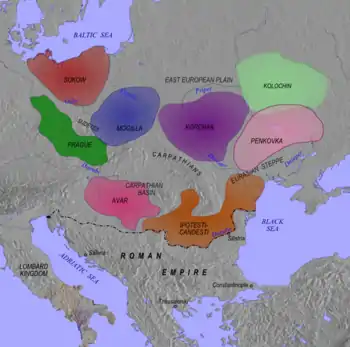Ipotesti–Candesti culture
The Ipotesti–Candesti culture (Russian: Ипотешти-кындештская культура) was an archaeological culture in Eastern Europe. It developed in the mid-6th century by the merger of elements of the Prague-Penkovka and Prague-Korchak cultures and local cultures (including Germanic) in the area between Prut and Lower Danube.[1] It stretched in the Lower Danube over territory in Romania and Moldavia.[2] The population of the area was made up of Romanized descendants of Daco-Getic, Germanic and Slavic tribes.[3] There are views that it derived from the Chernyakhov culture and represented a group of the Antes.[2] The houses were identical to the Slavic huts of the Prague-Korchak and Penkovka areas.[4] The sites in Romania are known as Ipotești-Candești-Ciurel[5] (Russian: Ипотешти-Кындешти-Чурел)[6] or Ipotești-Ciurel-Cândești.[7]

References
- Cvijanović 2013, pp. 334, 343.
- Васильев 2015, p. 1017.
- Cvijanović 2013, p. 334.
- Cvijanović 2013, p. 343.
- Andrzej Buko (2007). The Archaeology of Early Medieval Poland: Discoveries – Hypotheses – Interpretations. BRILL. pp. 70–. ISBN 978-90-474-2326-3.
- Константин Анисимов (2017). В поисках Олеговой Руси. Алгоритм. pp. 298–. ISBN 978-5-04-004759-8.
- Dolinescu-Ferche 1984.
Sources
- Cvijanović, Irena (2013). "The Typology of Early Medieval Settlements in Bohemia, Poland and Russia". In Rudić, Srđan (ed.). The World of the Slavs: Studies of the East, West and South Slavs: Civitas, Oppidas, Villas and Archeological Evidence (7th to 11th Centuries AD). Istorijski institut. pp. 289–344. ISBN 978-86-7743-104-4.CS1 maint: ref=harv (link)
- Dolinescu-Ferche, Suzana (1984). "La cultur "Ipoteşti-Ciurel-Cândeşti" (V-VII siècles)". Dacia. 28: 117–148.CS1 maint: ref=harv (link)
- Васильев, Г. Е. (2015). Русская историология. pp. 1017–. ISBN 978-5-4475-4624-3.CS1 maint: ref=harv (link)
Further reading
- Teodorescu, V., 1966. La civilisation Ipoteşti Cândeşti (Ve-VIIe siècles de. ne). Actes du VIIe Congrès International des Sciences Préhistoriques et Protohistoriques. Prague, pp. 21–27.
- Teodor, E.S., 2004. Un Update for ‘Ipoteşti-Cândeşti culture’. Zborník na počestDariny Bialekovej (Nitra: SAV), pp. 405–414.